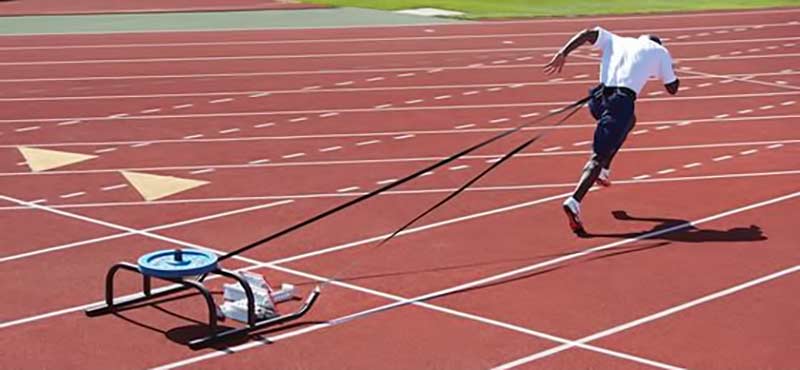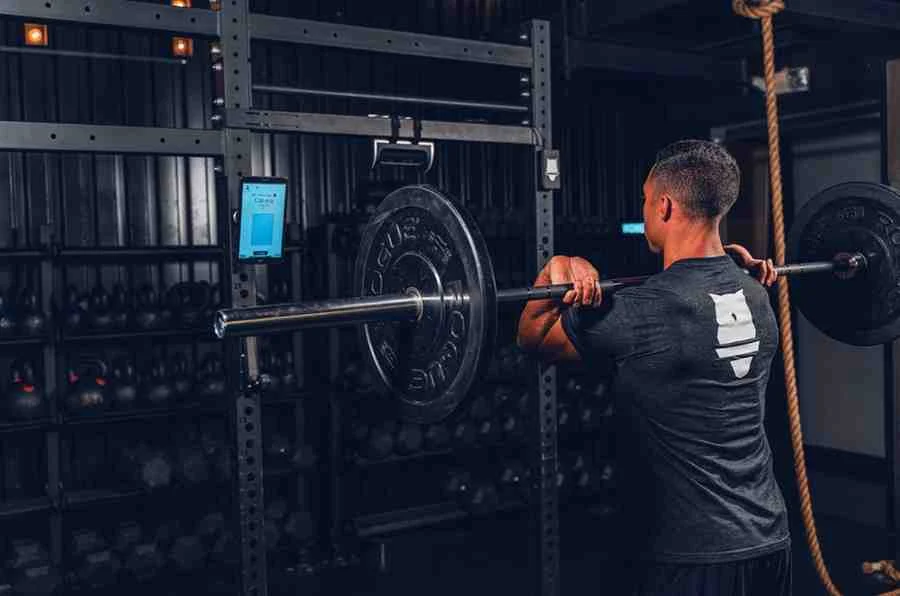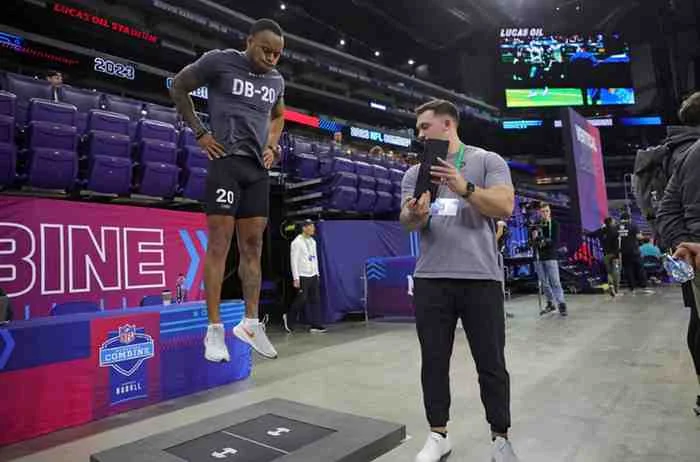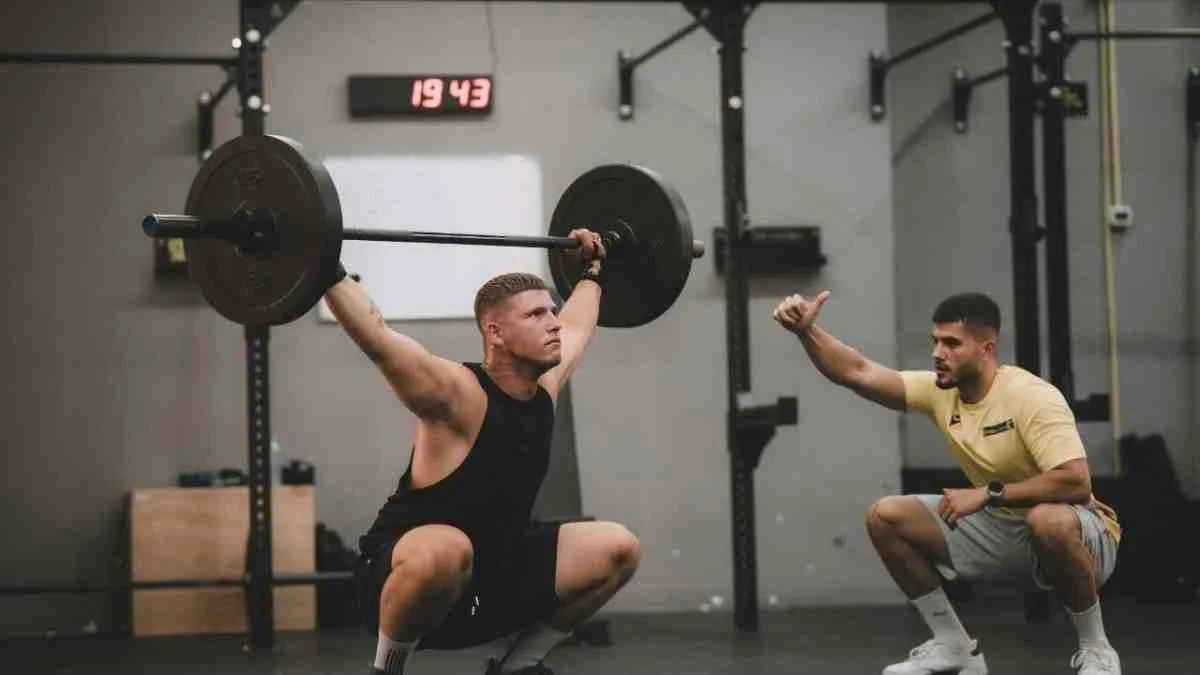[mashshare]

Accommodated resistance is growing in popularity with both individual and team-based sports. In the weight room, it helps develop power. On the field, it improves sprint power and acceleration mechanics. And in the pool, resisted swim training improves swim sprint performance and muscular strength.
Training with accommodated resistance, such as elastic bands, theoretically gives athletes greater mechanical advantage to assist in the eccentric phase of an activity, applying maximal stored energy into the concentric explosive movement.6 Due to the nature of elasticity, resistance increases through a movement’s concentric phase, and this increases muscle activation.66Power and Strength Development
Traditional power development methods involve training for speed and strength independent of each other. New age methods are emerging to produce an augmented training effect for peak power and strength development. One of these methods uses accommodated resistance. Explosive movements, such as those required in many sports, require an extremely quick rate of force development to perform with peak power, a combination of peak speed and strength.6
Rhea et al. (2009)6 compared the effect of heavy, slow movements to the effect of lighter, fast movements (Slow group) and compared fast movements with accommodated resistance (FACC) to determine the effects of each on peak power and strength development. The only variable that differed between the three test groups of Division I college athletes was the speed at which they performed a squat movement.
Strength improvements were comparable between the Slow and FACC groups. The FACC group, however, experienced a much greater training effect with power development: 17.8% versus 11% in the Fast group and 4.8% in the Slow group.
The theory behind using accommodated resistance in power training clearly has merit. The authors recommended that, as the strength of the athlete increases, the band tension must also increase. For maximal benefit, use a weight that allows the athlete to accelerate through the movement’s full range of motion.
Speed Development
Speed is a function of the optimal combination of stride frequency and stride length, which are considered antagonistic factors.5 Stride frequency depends on nerve conduction velocity and, therefore, is largely associated with a genetic ceiling.5 Because of this, adaptations to stride length are studied more frequently.5
In sprint training, accommodated resistance is often used to develop stride length. The athlete sprints while pulling an external load such as a sled or parachute.5 This type of training increases the power and strength of the leg’s extensor muscles by creating an overload stimulus to recruit additional fast-twitch muscle fibers.4

For athletes who aim to improve their sprint acceleration for specific sports, resisted sprint training is a valid method to develop strength within a training cycle. Sprinting while pulling an external load recruits additional fast-twitch motor units, improving sprint power and acceleration mechanics.1
Literature suggests that adding an amount of load which slows an athlete’s velocity by at least 10%, compared to unloaded sprinting, alters their sprinting mechanics.1 Pulling this amount of load should be avoided at all cost; the loss of proper mechanics can cause the athlete to develop improper neuromuscular movement patterns and less efficient sprint mechanics.
A study by Bachero-Mena and Gonza´lez-Badillo (2014)1 aimed to discover the optimal training load to improve sprint acceleration. Researchers tested three different external loads with 19 physically active males: 5, 12.5, and 20% of each person’s body mass (BM). After a 7-week resisted sprint training period, with two sessions per week, all three groups improved in 40m sprint time.
The heavy load group (20% BM) significantly improved their 0-20m and 0-30m sprint times. The light load (5% BM) and moderate load (12.5% BM) groups improved significantly in the flying phase but not in acceleration (Light: 10-40m and 20-40m; Moderate: 20-30m and 20-40m). Since the heavy load group trained at slower speeds, their flying phase intervals did not differ significantly from the initial baseline testing.
Resisted sprint training with various loads may improve an athlete’s specific weaknesses in their sprint, whether in the acceleration or the flying velocity phase. Depending on what an individual athlete needs to work on at various points in a training cycle, the appropriate load can be applied for maximal training enhancement.
Resisted sprints may improve an athlete’s weaknesses in acceleration and flying velocity. Share on XDeveloping acceleration calls for heavy loads near 20% of an athlete’s BM. Lighter loads from 5-12.5% of BM will improve flying velocity. It’s important to note that the study did not examine unloaded training compared to loaded training. Further research may examine the aggregate effect of both methods.
Makaruk et al. (2013)5 examined untrained, physically active female college students as they underwent either resisted (RTG) or standard sprint (STG) training. Researchers measured speed, flight time, ground contact time, stride length, stride frequency, and knee angle in a 20m sprint test. The RTG increased velocity due to increased stride length (slower ground contact time) while the STG exhibited a statistically similar increase in running velocity due to increased stride frequency related to decreased ground contact time.
In my opinion, the tradeoff between ground contact time and stride length is debatable. An increase in stride length also means an increased knee angle at foot strike which places additional stress on the hamstring group and increases the risk of injury.5 Increasing the knee angle for force production is also not optimal even though a degree of increased ground contact time allows for more force application. Lately, research has been leaning toward the benefits of improving ground contact time over any other kinematic factor in the running stride.
Another study by Luteberget et al. (2015) 4 performed a similar experiment on acceleration development in elite female handball players. In this 10-week study, only traditional sprint training improved 10m sprint time, while both resisted and traditional methods improved 30m sprint time.
Interestingly, this study also examined the training effects on muscle pennation and the lengthening of muscle fibers in response to the training stimuli of both groups. At any relative velocity, longer muscle fibers exerted more force than shorter fibers of the same thickness for sprint performance due to a larger power output of the knee extensor muscles.4
Swim Training
The use of resistance and assistance for speed development in ground running sports is common but less so in a non-impact sport such as swimming. Much like running speed is determined by the product of stride length and stride frequency, swim velocity is a function of stroke length and stroke rate.2 The terms overstrength and overspeed are often used when referring to resisted and assisted sprint training, respectively.2 Both high-resistance and high-velocity training are used to create positive development of power and movement speed through nervous system adaptations.2
A study by Girold et al. (2006) 2 compared overstrength and overspeed training in improvements in 100m sprint performance. In both groups, an elastic cord was attached to a swimmer to provide guided assistance ahead of the swimmer or resistance from behind. In the overstrength (resisted) group, the stroke rate, elbow extensor strength, and swim velocity improved, while stroke rate remained unchanged.
In the overspeed group, stroke rate increased, stroke length decreased, and swim velocity remained unchanged. Also, physical strength and the technical parameters directly correlated to swim velocity prediction. In this study, resisted swim training for three weeks improved sprint performance and muscular strength more than the assisted training.
Resisted swim training improved swim sprint performance and muscular strength. Share on XAnother 12-week study examined the effect of dry-land strength training versus resisted and assisted sprint training.3 Researchers found that stroke rate improved in the resisted sprint group. For the 50m sprint, however, there were no significant differences in swim velocity among any of the training groups, although they all improved.
The volume of training was greater in the previously mentioned study (ten versus six sessions per week), which may be why the researchers found no performance enhancement. The practical application of these findings is to incorporate a combined high-volume, high-resistance sprint regimen for the best improvements in swim strength and technical parameters.3
It appears we need more research into accommodated resistance for speed development on land. I’m not convinced that the sprint mechanics retain the same quality or specificity while pulling an external load, though the overload stimulus seems favorable for power development of swim speed. With its growing popularity, we can expect more research on accommodated resistance training in the coming decade.
Since you’re here…
…we have a small favor to ask. More people are reading SimpliFaster than ever, and each week we bring you compelling content from coaches, sport scientists, and physiotherapists who are devoted to building better athletes. Please take a moment to share the articles on social media, engage the authors with questions and comments below, and link to articles when appropriate if you have a blog or participate on forums of related topics. — SF
[mashshare]
References
- Bachero-Mena, B. & Gonza´lez-Badillo, J. J. (2014). “Effects of Resisted Sprint Training on Acceleration with Three Different Loads Accounting for 5, 12.5, and 20% of Body Mass.” Journal of Strength and Conditioning Research, 28(10), 2954–2960. doi:10.1519/JSC.0000000000000492.
- Girold, S., Calmels, P., Maurin, D., Milhau, N., & Chatard, J. (2006). “Assisted and Resisted Sprint Training in Swimming.” Journal of Strength and Conditioning Research, 20(3), 547-554.
- Girold, S., Maurin, D., Dugue, B., Chatard, J., & Millet, G. (2007). “Effects of Dry-Land vs. Resisted- and Assisted-Sprint Exercises on Swimming Sprint Performances.” Journal of Strength and Conditioning Research, 21(2), 599-605.
- Luteberget, L. S., Raastad, T., Seynnes, O., & Spencer, M. (2015). “Effect of Traditional and Resisted Sprint Training in Highly Trained Female Team Handball Players.” International Journal of Sports Physiology and Performance, 10(5), 642-647. doi:10.1123/ijspp.2014-0276.
- Makaruk, B., Sozanski, H., Makaruk, H., & Sacewicz, T. (2013). “The Effects of Resisted Sprint Training on Speed Performance in Women.” Human Movement, 14(2), 116-122. doi: 10.2478/humo-2013-0013.
- Rhea, M. R., Kenn, J. G., & Dermody, B. M. (2009). “Alterations in Speed of Squat Movement and the Use of Accommodated Resistance Among College Athletes Training for Power.” Journal of Strength and Conditioning Research, 23(9), 2645-2650. doi: 10.1519/JSC.0b013e3181b3e1b6.




